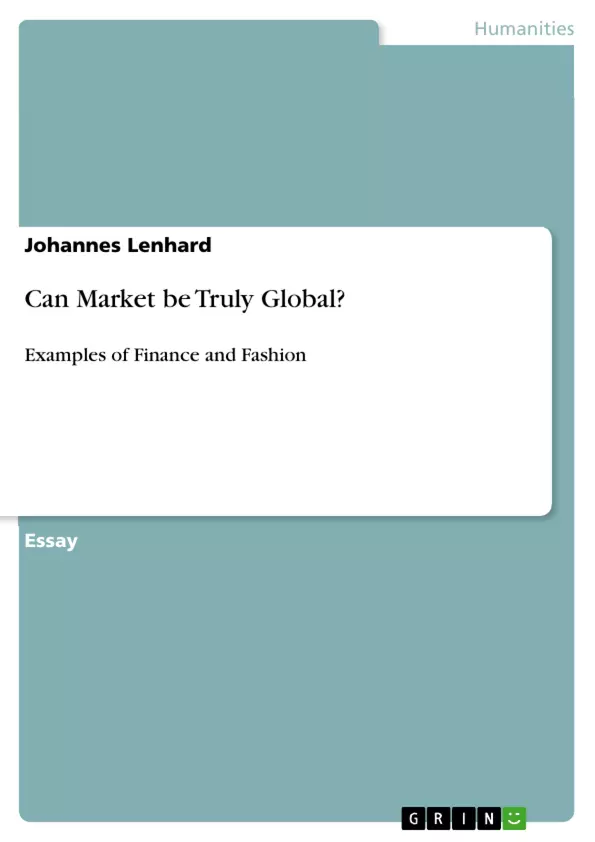The recent economic and financial crisis seems to give an easy answer to the question whether markets can be truly global. How is it possible that German municipalities go bankrupt because they bought American mortgage papers other than by the force of a truly global market? The world is flat (Friedman, 2007) – so markets can not be anything but global. However, as we will try to show in this essay, bold statements as well as seemingly bold questions such as ‘Can a market be truly global’ need to be treated with caution. What does it mean to be ‘truly global’? What after all is a ‘market’? It is those issues that need to be addressed first. The paper will afterwards demonstrate the case of two examples of markets, namely fashion and finance. Analysing the globality of those very different types, we will try to show that it is firstly important to be attentive in regards to different parts of markets: for example, does the consumption side in the particular fashion market analysed seem to be much less global than the production side. It is secondly important to consider non-economic parts of the market when judging the degree of globalness: the seemingly global foreign exchange market in finance for instance is indeed very much ‘embedded’ into both social and material contexts which makes it what is called a ‘global hybrid’ below. It is nationally grounded but trades globally. The exemplary discussion of fashion and finance will afterwards be contextualised with a more general critical section illuminating the arguments of Marxists and sceptical school thinking before we come to a conclusion.
Inhaltsverzeichnis (Table of Contents)
- I Introduction
- II Definitive Remarks: Markets and Global Markets
- III Fashion and Finance - Global Markets?
- A Fashion
- B Finance
Zielsetzung und Themenschwerpunkte (Objectives and Key Themes)
This essay aims to critically examine the concept of a truly global market by analyzing two specific examples: the fashion and finance sectors. It explores the challenges of defining a “global market” and examines whether global markets can truly exist in practice.
- Definition of a global market
- Role of national boundaries and state influence in markets
- Comparison of global and international markets
- Analysis of consumption and production in global markets
- Influence of cultural and social factors on market dynamics
Zusammenfassung der Kapitel (Chapter Summaries)
The introduction lays out the central question of the essay: Can a market be truly global? It explores the complexities of defining a global market and establishes a framework for the subsequent analysis.
Chapter II delves into the concept of markets, exploring different definitions and the role of embedding in cultural and social contexts. It also discusses the challenges of defining a truly global market and introduces the criteria for assessing globality.
Chapter III presents two examples of markets: fashion and finance. The fashion market is examined in terms of its consumption and production sides, highlighting the complexities of globality in this industry. The finance sector, specifically foreign exchange and corporate finance, is then explored to understand the role of globality in financial markets.
Schlüsselwörter (Keywords)
The key themes and concepts explored in this essay include global markets, international markets, market definitions, embeddedness, cultural influence, fashion industry, finance sector, foreign exchange, corporate finance, consumption, production, national boundaries, and state influence.
- Citation du texte
- Johannes Lenhard (Auteur), 2012, Can Market be Truly Global?, Munich, GRIN Verlag, https://www.grin.com/document/193222



